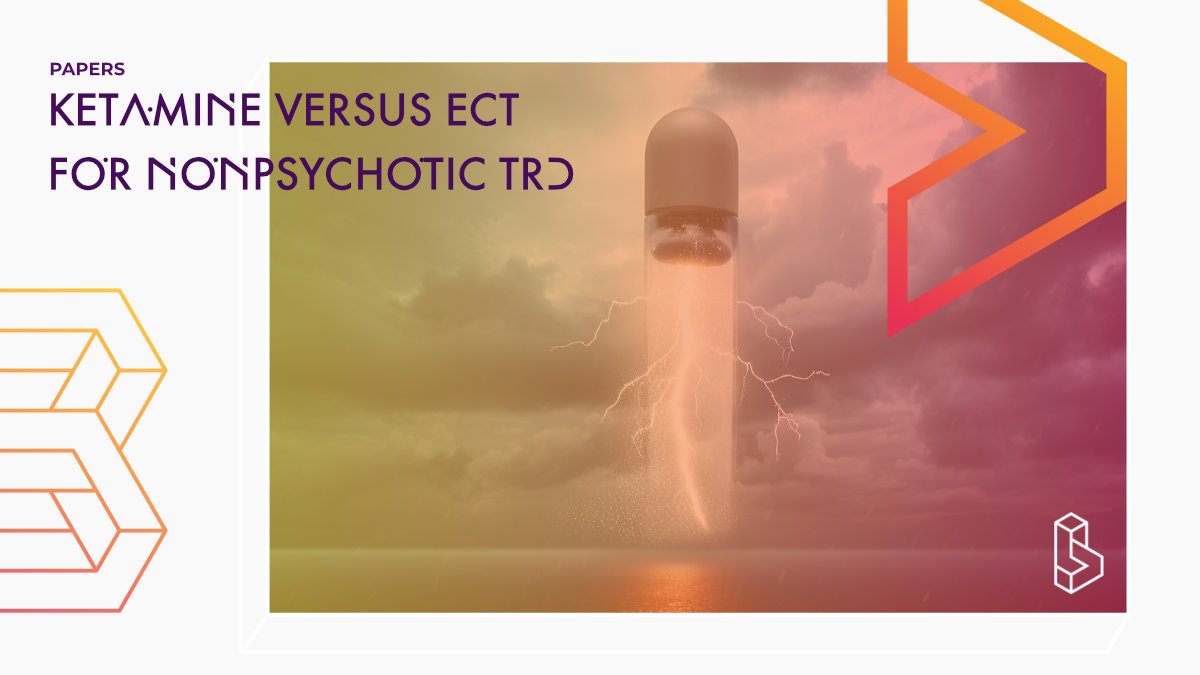This open-label, randomized trial (n=403) compared the effectiveness of iv ketamine (35mg/70kg, 6x, 3w) and electroconvulsive therapy (ECT) in treating treatment-resistant major depression (TRD). The results showed that 55.4% of patients in the ketamine group and 41.2% in the ECT group responded to the treatment, indicating ketamine was noninferior to ECT. ECT was associated with a temporary decrease in memory recall, while ketamine was associated with dissociation. Both treatments had similar improvements in patient-reported quality of life, with ECT having musculoskeletal adverse effects.
Abstract of Ketamine versus ECT for Nonpsychotic Treatment-Resistant Major Depression
“Background Electroconvulsive therapy (ECT) and subanesthetic intravenous ketamine are both currently used for treatment-resistant major depression, but the comparative effectiveness of the two treatments remains uncertain.
Methods We conducted an open-label, randomized, noninferiority trial involving patients referred to ECT clinics for treatment-resistant major depression. Patients with treatment-resistant major depression without psychosis were recruited and assigned in a 1:1 ratio to receive ketamine or ECT. During an initial 3-week treatment phase, patients received either ECT three times per week or ketamine (0.5 mg per kilogram of body weight over 40 minutes) twice per week. The primary outcome was a response to treatment (i.e., a decrease of ≥50% from baseline in the score on the 16-item Quick Inventory of Depressive Symptomatology–Self-Report; scores range from 0 to 27, with higher scores indicating greater depression). The noninferiority margin was −10 percentage points. Secondary outcomes included scores on memory tests and patient-reported quality of life. After the initial treatment phase, the patients who had a response were followed over a 6-month period.
Results A total of 403 patients underwent randomization at five clinical sites; 200 patients were assigned to the ketamine group and 203 to the ECT group. After 38 patients had withdrawn before initiation of the assigned treatment, ketamine was administered to 195 patients and ECT to 170 patients. A total of 55.4% of the patients in the ketamine group and 41.2% of those in the ECT group had a response (difference, 14.2 percentage points; 95% confidence interval, 3.9 to 24.2; P<0.001 for the noninferiority of ketamine to ECT). ECT appeared to be associated with a decrease in memory recall after 3 weeks of treatment (mean [±SE] decrease in the T-score for delayed recall on the Hopkins Verbal Learning Test–Revised, −0.9±1.1 in the ketamine group vs. −9.7±1.2 in the ECT group; scores range from −300 to 200, with higher scores indicating better function) with gradual recovery during follow-up. Improvement in patient-reported quality-of-life was similar in the two trial groups. ECT was associated with musculoskeletal adverse effects, whereas ketamine was associated with dissociation.
Conclusions Ketamine was noninferior to ECT as therapy for treatment-resistant major depression without psychosis.”
Authors: Amit Anand, Sanjay J. Mathew, Gerard Sanacora, James W. Murrough, Fernando S. Goes, Murat Altinay, Amy S. Aloysi, Ali A. Asghar-Ali, Brian S. Barnett, Lee C. Chang, Katherine A. Collins, Sara Costi, Sidra Iqbal, Manish K. Jha, Kamini Krishnan, Donald A. Malone, Sina Nikayin, Steven E. Nissen, Robert B. Ostroff, Irving M. Reti, Samuel T. Wilkinson, Kathy Wolski & Bo Hu
Summary of Ketamine versus ECT for Nonpsychotic Treatment-Resistant Major Depression
Major depressive disorder is a leading cause of disability worldwide, affecting 21 million adults in the United States.
Electroconvulsive therapy (ECT) has a track record of nearly 80 years as an effective strategy for treatment-resistant major depression but remains underused owing to social stigma and concerns regarding cognitive impairment.
Ketamine, an N-methyl-d-aspartate receptor antagonist, has been shown to have an antidepressant effect in patients with major depressive disorder and treatment-resistant major depression. However, a pragmatic comparative-effectiveness trial of ketamine and ECT for treatment-resistant major depression was conducted.
Find this paper
Ketamine versus ECT for Nonpsychotic Treatment-Resistant Major Depression
https://doi.org/10.1056/NEJMoa2302399
Paywall | Google Scholar | Backup | 🕊
Cite this paper (APA)
Anand, A., Mathew, S. J., Sanacora, G., Murrough, J. W., Goes, F. S., Altinay, M., ... & Hu, B. (2023). Ketamine versus ECT for Nonpsychotic Treatment-Resistant Major Depression. New England Journal of Medicine.
Study details
Compounds studied
Ketamine
Topics studied
Treatment-Resistant Depression
Depression
Study characteristics
Open-Label
Randomized
Participants
403
Humans
Linked Clinical Trial
ELEKT-D: Electroconvulsive Therapy (ECT) vs. Ketamine in Patients With Treatment Resistant Depression (TRD)The goal of the study is to conduct a comparative randomized trial of electroconvulsive therapy (ECT) vs. ketamine for patients with treatment resistant depression (TRD) in a real world setting with patient reported outcomes as primary and secondary outcome measures.

